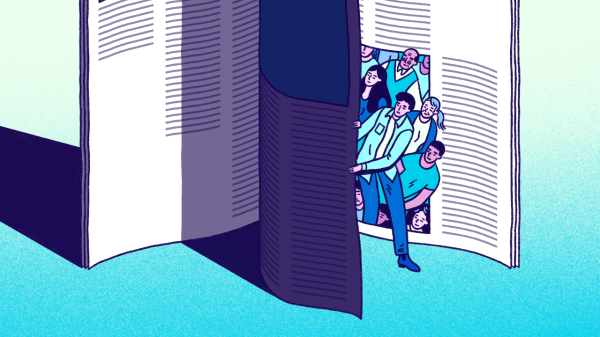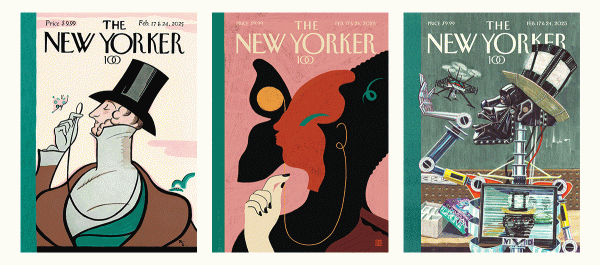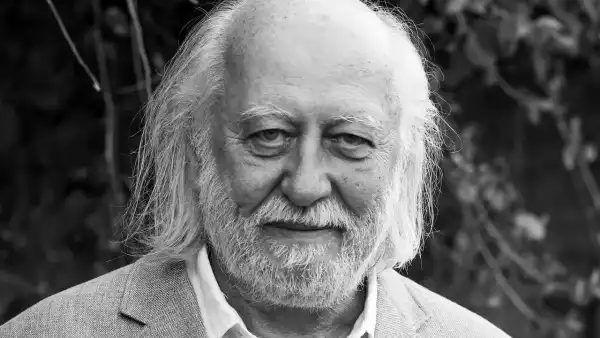
Save this storySave this storySave this storySave this story
Early in Ian McEwan’s novel “Atonement,” from 2001, a young girl sits on the floor, considering how strange it is to have a body. She looks at her hand: Isn’t it odd that “this machine for gripping, this fleshy spider,” is part of her? She bends a finger, then straightens it. “The mystery was in the instant before it moved, the dividing moment between not moving and moving, when her intention took effect,” she thinks. “It was like a wave breaking. If she could only find herself at the crest, she thought, she might find the secret of herself, that part of her that was really in charge.”
The 100th Anniversary Issue
Subscribers get full access. Read the issue »

When I read “Atonement,” in college, I loved this passage. My father was a neuroscientist, and we often talked about the brain; like the girl in the novel, I was fascinated by the connection between our bodies and our minds. I also admired McEwan’s style. There was an openly intellectual, almost technical feeling to his language, which suggested a pleasing convergence of art and science—a tone tailor-made for an English major with a scientist dad.
“Atonement” isn’t really a novel about science; a morality tale, it follows someone who makes a disastrous choice and then tries to make up for it. But McEwan’s next novel, “Saturday,” had a brain surgeon as its protagonist, and centered on what philosophers call the mind-body problem—the question of how the physical stuff out of which we’re made relates to the subjective experience we have as beings with consciousness. “Could it ever be explained, how matter becomes conscious?” the surgeon asks himself while operating on the brain of a patient. No one knows exactly how “this well-protected one kilogram or so of cells” actually “holds experiences, memories, dreams and intentions,” he thinks. Even if that mystery is someday solved, “the wonder will remain, that mere wet stuff can make this bright inward cinema of thought, of sight and sound and touch bound into a vivid illusion of an instantaneous present, with a self, another brightly wrought illusion, hovering like a ghost at its centre.” In the novel, a deranged man breaks into the surgeon’s house. Is the man responsible for his actions, or is his brain at fault? If his brain is driving him—presumably, our brains drive all our actions—does that somehow make him less of a person?
By the time I read “Saturday,” in 2005, I was in graduate school, studying for a Ph.D. in English. For my dissertation, I’d decided to look at how novels thought about the mind in the age of neuroscience. “Saturday” was part of a long tradition: Camillo Golgi devised a technique for seeing the details of neurons in 1873, the same year Leo Tolstoy started writing “Anna Karenina,” and over the next century, as scientists came to understand more about the brain, novelists grew increasingly determined to portray the workings of mental life. Many novels asked questions that were also posed by philosophers: Did we have free will? How connected were language and thought? Were we just our brains, or something more? The philosophical hero of my dissertation, a professor named David Chalmers, was famous for articulating what he called the hard problem: “How does the water of the brain turn into the wine of consciousness?” (Perhaps McEwan’s brain surgeon had read him.) In Chalmers’s mind, science offered no good explanation for how an object could develop a first-person point of view. The dissertation’s villain, meanwhile, was Chalmers’s nemesis, Daniel Dennett. Dennett, who was also a philosopher, maintained that there was no hard problem. He compared the mind to a computer program running on the hardware of the brain—what’s mysterious about that?—and, in an influential book, “Consciousness Explained,” characterized people like Chalmers as suffering from “Philosophers’ Syndrome: mistaking a failure of the imagination for an insight into necessity.”
I read “Consciousness Explained,” and a few of Dennett’s other books, and immersed myself more generally in the field known as philosophy of mind. I was thoroughly unconvinced by his materialist position. He believed that there was no fundamental contradiction between the subjective and the objective points of view; whether we perceived something as an object or a subject simply depended on the “stance” we took toward it. I couldn’t see how this made sense. In fact, the book made me a little angry. I was with Vladimir Nabokov, who, when asked what surprised him most about life, referred to “the marvel of consciousness—that sudden window swinging open on a sunlit landscape amidst the night of non-being.” I felt that Dennett, and those who thought along similar lines, dismissed the uniqueness and sacredness of human existence.
My academic advisers, who had indulged me by letting me pursue my project, indulged me further as I added more philosophers, and bigger and more forbidding novels, into the mix. Years passed. I read and reread, drafted and deleted. Eventually, I realized that I didn’t want to be a professor after all, and left my graduate program. I never finished my dissertation. But I profited from the experience of working on it. I read a lot of great books. And I arrived at certain opinions about the big questions that fascinated me—opinions that I believed were well founded, and unlikely to change. I’d read so much that I figured I knew what I was talking about.
In 2017, Dennett published a book called “From Bacteria to Bach and Back: The Evolution of Minds.” I learned about it in advance, from the publisher’s publicity department. By then, I was a journalist; my academic life was a decade in the past. In an e-mail to my editors proposing that I write about the book, I noted that I disagreed with Dennett “on many fronts,” and then added, “But what do I know?” At some point, my convictions had cooled. I’d also noticed how good journalism often emerges from the convergence of disagreement and befuddlement.
Eventually, my editors and I decided that, instead of reviewing the book, I should write a Profile of Dennett—a long piece that described him as a person, and recounted the course of his life. Dennett was game, and he and I arranged to meet for the first time in Seattle, where he would be attending a conference. I’d spend a few days with him there, watching him argue about the mind with some philosophers and scientists. Then, later in the month, I’d meet up with him again in Boston (he was a professor at Tufts), attend his annual black-tie Christmas party (punch, piano, carolling), and then drive with him and his wife, Susan, to Maine, where they’d lived for many years. After staying there for several days, I’d return to New York to interview Chalmers, who now taught at N.Y.U., and then draft my story.
I’d written all sorts of pieces—reviews, criticism, essays—but never a Profile. I was nervous, both interpersonally and intellectually, about spending so much time with an eminent philosopher whose ideas vexed me. I reread Dennett’s books as if I were preparing for an exam. I was taking the scholarly approach. In academia, you proceed methodically, identifying a question and then studying it; you read what’s been written and talk it over with colleagues or students; you design experiments, or teach seminars, or write papers, with the aim of becoming an expert and of developing an original view. Failing that, you at least try to explore your question rigorously and systematically. You don’t proceed by attending someone’s Christmas party and then driving with them to Maine.
That approach—reporting—had always struck me as a little odd. Didn’t it risk introducing an element of the arbitrary into an otherwise objective process? If you wanted to understand complex questions in philosophy, was hanging out with a single philosopher the right idea? What was the point of knowing what such a person did, or wore, or ate, on the particular days when a reporter visited? Part of me gravitated toward a more disembodied way of working. I wanted to stay in the world of thought. I was still in my grad-school era.
It was cloudy in Seattle, and snowy in Boston and Maine; Dennett liked the snow. He walked with a wooden stick he’d carved himself. He had a jolly, indefatigable, relentless energy. He could do seemingly anything—play piano, call a square dance, glaze a window, whittle, sail. When you talked to him, he stared at you, heavy-lidded, then disabused you of your misconceptions, but warmly, the way a coach guides a player. I learned a lot about Dennett as a person during the time we spent together.
I also learned a lot about the value of being there. For one thing, I’d underestimated the importance of time. Reporting meant hours of conversation in the car; room for asking the same questions over and over; the gradual diminishment of one’s embarrassment about being ignorant or uncertain; a dilatory attitude of quiet listening and watching; the possibility of misunderstandings resolved. Patient, smart, and imaginative, Dennett could explain concepts from every angle, inventing new ones if given the time. And I also hadn’t reckoned with the communicativeness of personality—the fullness of an individual, even briefly glimpsed, and what it suggested about what they might know. What is a materialist philosopher—a person who doesn’t believe we have souls—supposed to be like? I’d had a picture in my head, something involving coldness, bluntness, harshness, and it was wholly wrong, a caricature waiting to be erased. It wasn’t so much that Dennett’s personality made me reconsider his ideas, but that his specificity made me consider them more specifically. The more you know a person, the more interesting they become. This can be true not just for who they are but for how they think. And the stakes are higher when you’re face to face. It’s easy to close a book, and harder to end a conversation.
I finished a draft of the Profile soon after my return, and sent it to my editor; he called me only a few minutes later. Just by scrolling through the document, he said, and registering the blocky regularity of its paragraphs, he could see what the problem was: the piece was like a big essay. There needed to be “scenes,” sections that read as though they could be in a novel—exchanges of dialogue, moments of action, tiny little paragraphs suggesting eruptions of physicality. I’d been there in person. What had happened? Readers wanted to be there, too.
I knew about these sorts of scenes; I’d read them in other profiles, but also studied them in novels. In a play, a scene was something formal: a unit of drama, an extended interaction with a clear beginning and end. A scene in a novel could be equally structured, or it could be slippery and elusive—just a beat of concrete reality, or a flash of seeing. A surgeon opening a skull could be a scene; so could a girl waggling her fingers. Scenes could be made simply, of instants beaded together. In “Saturday,” the surgeon “takes a scalpel and makes a small incision.” He asks another doctor, “How much blood have we lost?” A different surgeon grasps a special tool, the Adson forceps. He “uses the Adson to lift out the congealed blood.” This combination of minute narration and distinct, sometimes esoteric or opaque detail—what do Adson forceps look like, exactly?—can conjure the illusion that we’re seeing something real. It can create what the literary theorist Roland Barthes called “the reality effect.”
Gérard Genette, another literary theorist, noticed that novelistic scenes often rely on “pseudo-iterative” thinking. In a novel, we see something happening just once, in a particular way, and yet the implication is often that it happens that way all the time. When we read “Saturday,” we learn about a particular brain surgery, but we also see how such surgery tends to unfold. When we read “Atonement,” we watch a particular girl thinking, but we also recognize how people tend to think about their bodies and minds. And so a scene is never only a scene; it’s a doorway into the rhythms, patterns, and structures of life. (At least, that’s what it is ideally. Scenes can have the power to mislead us into an inaccurate view of what typically happens. The particulars might be right, but the implication can be wrong.)
After hearing from my editor, I knew which scenes I wanted to include, which patterns or structures I wanted to illustrate. I needed a scene in which Dennett argued with other philosophers; best of all would be a debate with his nemesis David Chalmers. Although I’d spoken to Chalmers separately, I hadn’t actually watched him spar with Dennett. I had, however, found a recording of one of their confrontations, during which Chalmers accused Dennett of “not taking consciousness seriously,” and Dennett responded substantively, and almost angrily, before smiling and suggesting that it was time to head to the bar. The scene would be important, I thought, not only because it captured Dennett in his element, and not only because it included the voice of his primary opponent, but because it showed him being misunderstood, and perhaps misunderstanding someone else. Novels, the critic Mikhail Bakhtin once wrote, are uniquely capable of containing a multiplicity of voices in tension; a reader sees characters tussling over meanings, feelings, ideas, and has the experience of “coming to know one’s own language as it is perceived in someone else’s language, coming to know one’s own belief system in someone else’s system.” Some novels, Bakhtin thought, even allow us “to imagine and postulate a unified truth that requires a plurality of consciousnesses,” a perspective that is “born at a point of contact” between people. By knitting together those voices, a profile could similarly allow readers to consider the possibility that all the sides of an argument were, together, right.
I wondered, as I wrote these scenes, about what it meant to fuse literary technique with journalistic fact. I combed through my recordings, notes, and photographs to get all the details exactly right; those details, which would later be verified by fact checkers, were then woven together into something simultaneously nonfictional and dramatic. Braided with essayistic and even scholarly excursions, they created something both exotic and familiar. Was the final product a piece of biography? An intellectual investigation? A record of a real-life encounter between a journalist and a subject? The requirements placed on the story were severe: it had to be a certain length, and have a certain form, and possess the right parts in the right proportion. But it afforded me, as a writer, a special kind of freedom I hadn’t previously found.
As it happened, Dennett persuaded me. By the time I’d finished writing the Profile, I no longer believed in the hard problem—and I no longer felt that denying its existence was a slight against my idea of what it meant to be human. The experience left a high watermark in my intellectual life. Ever since, I’ve found it difficult to be satisfied with reading or thinking on my own. If someone’s ideas fascinate, perplex, or frustrate me, I want to get to know the person. If I don’t understand some question, I want to “report it out.” I’ve become painfully aware of how much of what I know, or think I know, could alter in the course of a reportorial process. Recently, when some parents at my son’s school became incensed about developments at the state’s education department, I found myself asking whether anyone had actually called up the department and asked what was up. If I finish a novel and can’t stop thinking about it, my mind turns inevitably to the idea of the novelist as an individual: Who is she, up close, and how does she really live and think?
There are limits to this way of approaching the world. Not all questions benefit from being explored narratively; sometimes we want statistical coolness, dispassionate objectivity, scientific clarity. In an era of endlessly revised alternative facts, there’s immense value in the simple and consistent articulation of what’s been rigorously shown to be true. Meanwhile, artificial intelligence can seemingly write about anything, synthesizing what’s already known, bending it into desirable and useful configurations, producing lengthy reports on any subject on demand, without obvious human fingerprints. The strangeness of literary journalism—with its recording of an idiosyncratic collision between a writer and a subject, its melding of the subjective and the objective—stands in ever-greater relief.
Dennett died last year, at the age of eighty-two. When I heard the news, I spent a while leafing through his books, revisiting the highlighted passages that had struck me most. (The tangible, entirely nonmystical complexity of the natural world, he wrote, was staggering and awe-inspiring—“greater than anything any of us will ever conceive of in detail worthy of its detail.”) I also reread the Profile. In her book “The Situation and the Story,” Vivian Gornick suggests that all literary writing has both a concrete and an emotional aspect. Elizabeth Bishop’s poem “In the Waiting Room,” for example, is concretely about a young girl sitting in a dentist’s office, perusing an issue of National Geographic and overhearing her aunt, who is in the dentist’s chair, cry out in pain; it’s emotionally about that same girl’s “first experience of isolation”—“her own, her aunt’s, and that of the world.” The concrete part is the situation. The emotional part is the story. It’s easy, Gornick thinks, to describe a situation, and much harder to recognize a story, even when it’s yours.
What story had I told? I’d shown Dennett, I believed, as a person determined to convince others of views that he thought were right, but that they found inconceivable; tirelessly, generously, tenaciously, brooking no resistance, he pushed and pushed against their intuitions, knowing that they might well return to their original incorrect shapes once his pushing ceased. His story was about faith in other people, and the toughness it required. And my story—since I was in the Profile, too—was about being pushed, and resisting it, and then being grateful for it. A reporter is often pictured as an active person, rushing around, finding things out, and this isn’t wrong. But, at the same time, the reporter is not totally in charge; he’s involved, available, subject to his subject. As readers, we get to watch as the writer’s wave breaks against the shore he finds. ♦
Sourse: newyorker.com







